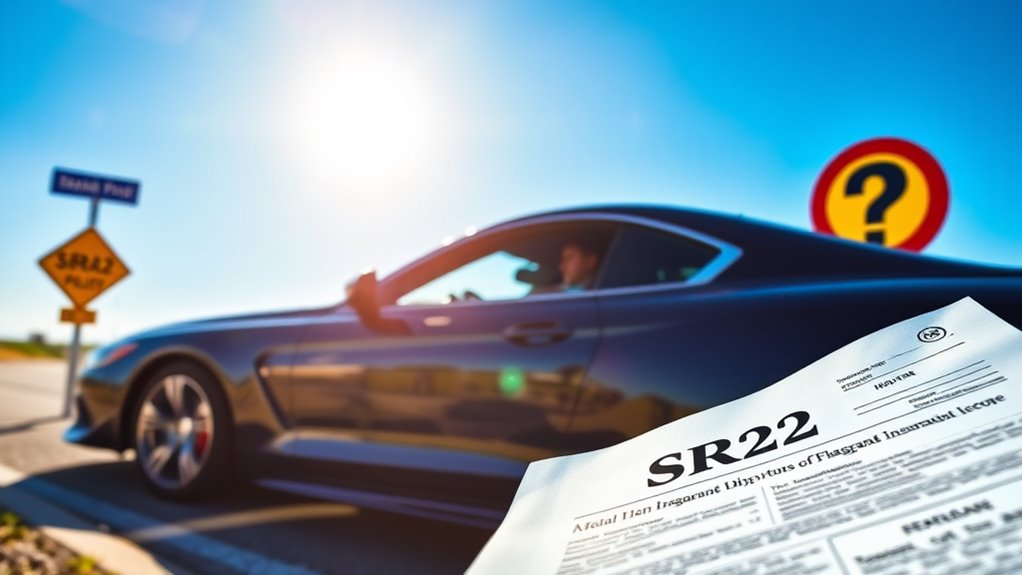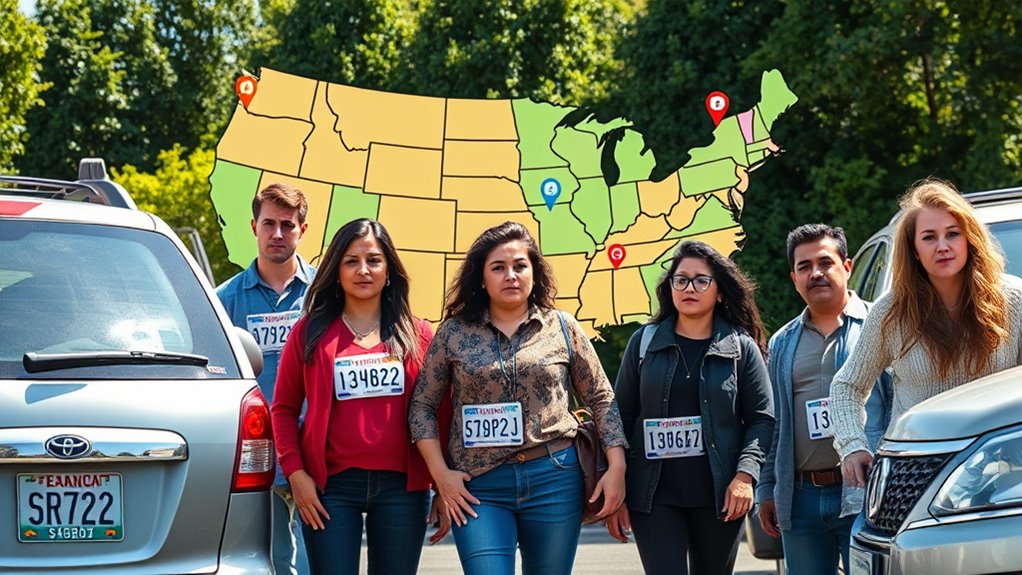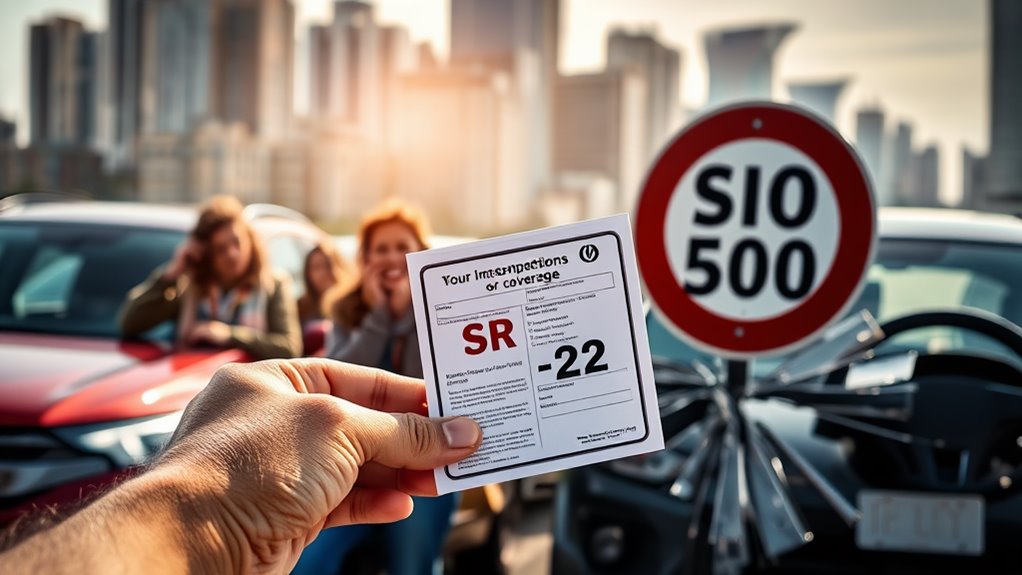If you're steering through the world of SR-22 insurance, you might be misinformed about some key aspects. Many drivers mistakenly think SR-22 is a separate policy or that it guarantees full coverage. You might also believe that vehicle ownership is a requirement to obtain one. Understanding these misconceptions can greatly impact your insurance decisions. Let's unpack these misunderstandings and clarify what you really need to know about SR-22 insurance.
Key Takeaways
- SR-22 is not insurance; it's a state-required form proving minimum liability coverage.
- Full coverage insurance is separate and not guaranteed by having an SR-22.
- You can obtain an SR-22 without owning a vehicle through a non-owner policy.
- SR-22 requirements vary by state, including duration and offenses triggering the need.
- While premiums may rise due to SR-22, shopping around can help find better rates.
SR-22 Is a Separate Insurance Policy

Many drivers mistakenly believe that SR-22 is a separate insurance policy, but that's not the case. Instead, it's a form filed with the state, verifying you meet minimum liability insurance requirements. Often referred to inaccurately as "SR-22 insurance," it misrepresents its true nature. To fulfill the SR-22 requirement, you must obtain an auto insurance policy that meets or exceeds your state's minimum coverage levels. Even if you don't own a vehicle, you'll need a non-owner SR-22 policy for liability coverage when driving non-owned cars. Remember, the SR-22 form doesn't automatically provide additional insurance benefits; it simply serves as proof of your compliance with state regulations. SR-22 insurance in Ohio is a crucial step for drivers looking to reinstate their driving privileges after certain violations. Understanding this distinction is essential for maneuvering your insurance needs effectively. Additionally, the SR-22 must be filed by insurance companies with state DMVs to ensure compliance.
SR-22 Automatically Provides Full Coverage
While some drivers might assume that obtaining an SR-22 automatically grants full coverage, this misconception can lead to unexpected gaps in protection.
An SR-22 is merely a certificate of financial responsibility that confirms you meet your state's minimum liability insurance requirements. It doesn't provide full coverage, which includes thorough and collision protections.
You can opt for full coverage, but it's not mandated by the SR-22 filing. Remember, state minimums vary, affecting what you must cover.
Maintaining continuous coverage that meets these minimums is vital to avoid license suspension. Understanding these distinctions helps you make informed decisions about your insurance needs and guarantees you're adequately protected while fulfilling SR-22 obligations.
Vehicle Ownership Is Required for SR-22
Contrary to popular belief, you don't need to own a vehicle to obtain an SR-22 certificate. If you're a driver without a car, you can still comply with SR-22 requirements through non-owner policies.
Here are key points to take into account:
- Coverage for Borrowed Cars: Non-owner SR-22 policies cover you when driving vehicles you don't own.
- Cost-Effective: These policies are generally cheaper than standard owner policies.
- Compliance: They make certain you meet state financial responsibility requirements.
- No Vehicle Ownership Needed: Vehicle ownership isn't a requirement for obtaining an SR-22.
All States Have the Same SR-22 Requirements

Understanding SR-22 insurance can be complicated, especially when it comes to the varying requirements across states. Not all states have the same SR-22 laws; in fact, some, like New York and Pennsylvania, don't require it at all.
The duration for maintaining an SR-22 can range from one to five years, depending on the state. Additionally, different offenses—like DUIs or reckless driving—may trigger SR-22 requirements in some states but not in others.
Coverage levels also differ; for instance, Arizona has lower minimum liability requirements than Texas. If you move to a new state, you'll need to adhere to your original state's SR-22 rules until your obligation ends, regardless of local regulations.
SR-22 Leads to Unaffordable Insurance Premiums
When you face an SR-22 requirement, it's easy to assume your insurance premiums will skyrocket, but the reality is more nuanced. Several factors contribute to your insurance costs, including:
- Type of Violation: Serious offenses like DUIs can increase rates considerably.
- Driving History: A clean record helps keep premiums lower, while multiple infractions raise costs.
- Insurer Differences: Various companies assess risk differently, meaning rates can vary widely.
- State Variance: Insurance costs fluctuate by state, impacting your overall premium.
While premiums may rise temporarily—by 27% to over 80%—it's essential to shop around.
Premiums can increase significantly, but exploring options can lead to more affordable rates.
You might find competitive rates that don't break the bank, especially if you've just had a minor infraction.
Maintaining SR-22 Is Optional After a License Suspension
Maintaining an SR-22 isn't optional after a license suspension if you want to regain your driving privileges. It's a mandatory requirement tied to certain offenses, ensuring you meet minimum liability insurance standards.
If you don't comply, you risk further fines and extended suspensions. There's typically no grace period, so continuous coverage is vital. Insurers are obligated to inform the DMV about any lapses, leading to immediate consequences.
The SR-22 requirement is often court-mandated, underscoring its significance. Failure to maintain it can jeopardize your license status and result in additional penalties.
To navigate this process smoothly, it's important to communicate with your insurance provider and remain vigilant about your coverage throughout the required duration.
SR-22 Covers All Types of Driving Offenses

While many believe that SR-22 coverage applies to all driving offenses, it actually serves a more specific purpose.
SR-22 is a document confirming financial responsibility, required for serious violations. Here are the main offenses that typically necessitate SR-22:
- DUI/DWI Convictions: Often the most common trigger for SR-22 requirements.
- Driving Without Insurance: This serious lapse can lead to mandated SR-22 coverage.
- Accumulating Points: Multiple points on your driving record may require SR-22 filing.
- Leaving the Scene of an Accident: Some states enforce SR-22 after this violation.
Conclusion
Maneuvering SR-22 insurance can feel like walking through a maze, but understanding these common misconceptions can light your path. Remember, an SR-22 isn't a standalone policy, and it doesn't guarantee full coverage. It's crucial to stay informed about state-specific rules and the impact on your premiums. By dispelling these myths, you can make smarter decisions and guarantee you meet your financial responsibility requirements without unnecessary stress. Stay aware, and you'll steer clear of potential pitfalls.

